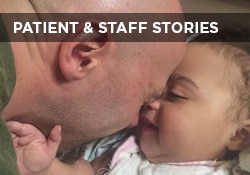This website uses cookies so that we can provide you with the best user experience possible. Cookie information is stored in your browser and performs functions such as recognising you when you return to our website and helping our team to understand which sections of the website you find most interesting and useful.

Susan E. Mazer, Ph.D. Blog
Thoughts and ideas on healthcare
Hi, and welcome to my blog! I'm Susan E. Mazer -- a knowledge expert and thought leader on how the environment of care impacts the patient experience. Topics I write about include safety, satisfaction, hospital noise, nursing, care at the bedside, and much more.
How Can Patients Be More Involved in Their Pain Management?
April 14, 2017
 The Opioid Epidemic is the result of relying solely on drugs to remove all pain.
The Opioid Epidemic is the result of relying solely on drugs to remove all pain.
But, it’s time to rethink what is possible when patients are fully involved in understanding and contributing to their own pain management.
Bringing pain down to a manageable level may not be removing it. However, it allows patients to safely engage in their own healing.
So much is not understood about pain. Patients often do not know how to adequately describe their pain to a doctor or nurse. Language is far from adequate.
However, pain is not a disease, but rather a symptom — the cause of which may be unclear.
History of Pain
In the 17th Century, French philosopher and scientist Rene Descartes presented the mind-body duality, which claimed that the mental and physical couldn’t influence each other. So, medical professionals began to look at the body mechanistically and treatment was limited to the biology of the patient.
All of this was easier to accept before research showed that the brain is involved. The initial theory of psychologist Ronald Melzack and colleague Kenneth Casey suggested a kind of “pain center.”
With the introduction of a Functional MRI (fMRI), scientists have been able to learn that multiple places in the brain are activated by pain, including cognition, reflex, executive function, and emotions. By connecting with all of these responses, people can find optimal relief from suffering.
Understanding & Managing Pain
Research has also shown that the pain experience is informed by personal history, family and social systems, and values and beliefs. And, as it is with pain and patients’ recovery.
The questions to consider for pain management are not only about whether patients are fully relieved of all pain, which may not be possible. They are perhaps more about whether clinicians have empowered patients to use their own power to manage, understand, and mitigate their suffering.
Ancient Greek philosophers Aristotle and Plato claimed that pain is an emotion; it is a human experience that may or may not be related to tissue damage or injury. As such, it will manifest in physical discomfort with or without an obvious cause.
In fact, the experience itself lives uniquely in each patient and is expressed as a sensation while it triggers none of the senses. So, while the feeling of pain is physical, but the cause of pain is more complex.
Stopping the Opioid Epidemic
Drugs can mitigate the pain, but may not totally safely remove it. This means patients may have reduced pain, moving their pain rating from an 8 to a 4 or less.
Right now, the Opioid Epidemic rages and grows with the cause being linked to over-prescribing of pain medication — which may have been partly caused by pressure on the medical community to improve HCAHPS scores.
Addiction starts as a part of a treatment and continues long after the original injury is healed. However, this is not merely any addiction. It is a global pandemic.
According to the Center for Disease Control (CDC), “since 1999, the number of people who have died from overdoses of either prescription opioids or heroin has nearly quadrupled in the United States…28,000 people died from overdosing on opioids. At least half of those deaths involved a prescription opioid.”
The objective was pain relief; now the relief has become toxic with risk of death.
No Easy Answer for Pain Relief
At this moment, in every hospital, at every patient’s bedside, the question of pain relief dominates and the opioid risk is ever present. And there is no easy answer.
In his book, The Anatomy of an Illness, Norman Cousins explains why watching old comedy movies starring the Three Stooges or Charlie Chaplain (or any movie that is really funny) gave him over three hours of pain-free living.
That is still true. Laughter is healing. As is engaging in beauty, listening to music, watching a movie or television program, or having a great discussion. Each of these can be a positive distraction that has been shown to relieve pain.
The C.A.R.E. Channel provides respite from the mental anguish that can be generated by pain and the diagnosis that brought a patient into the hospital. It is offered and intended to be available over the full 24-hour patient day and night, because anguish, fear, and suffering are not loyal to any schedule.
C.A.R.E. with Guided Imagery offers a narrative, a different story to ponder, and a framework to strengthen the patient’s own capacity to heal. When integrated with medication, patients can use these conscious tools again and again, often reducing the need for more analgesics.
Here are five things to consider in getting patients more involved in their pain management:
- The emotional and social context that surrounds patients informs their ability to self-regulate pain. They can make it better or worse.
- Combining pharmaceuticals with alternative non-pharmaceutical methods can result in better pain management.
- Patients’ own beliefs in their capacity to deal with their pain together with the support and encouragement of nurses and physicians are optimal. Optimism is better than pessimism.
- Positive distractions, such as nature video, music, movies, or other activities is better than patients being left only with their pain to think about.
- A plan for what to do at home, beyond medication, can prevent re-admissions.
More About Pain
If you’d like to learn more about how The C.A.R.E. Channel can help with pain management, please join me on Tuesday, April 25 at 11 a.m Pacific for a 30-minute webinar. >Get more information and register.
One More Thing
The C.A.R.E. Channel is 25 years old this year! Check out this timeline of significant company milestones and events that have changed healthcare since 1992.
P.S. If you like this post, please do me a favor and share on LinkedIn, Twitter, Facebook, etc. Also to get automatic notices when a new post is published, subscribe (upper right). No spam – just great content. Thanks!










